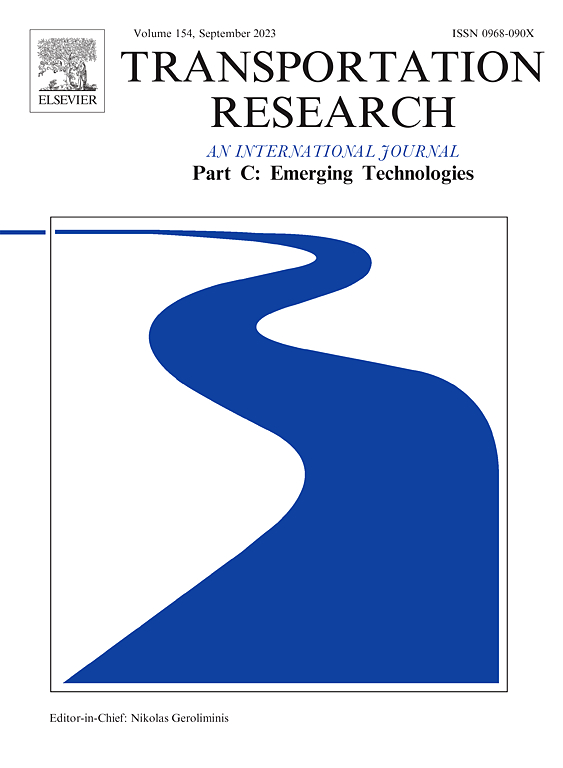利用自然车辆轨迹进行变道失败检测和预测
IF 7.6
1区 工程技术
Q1 TRANSPORTATION SCIENCE & TECHNOLOGY
Transportation Research Part C-Emerging Technologies
Pub Date : 2024-11-19
DOI:10.1016/j.trc.2024.104939
引用次数: 0
摘要
变道机动是与各种碰撞(如追尾和侧擦碰撞)密切相关的关键驾驶行为。精确预测变道操作可以帮助驾驶员做出明智的决策,从而提高驾驶安全性。然而,现有研究主要关注成功的变道操作,而忽略了失败的变道操作。本研究利用自然车辆轨迹数据,全面研究了在自由裁量场景下变道失败的检测和预测。研究采用墨西哥帽小波(MHW)来准确检测变道成功或失败事件的关键时间点,包括变道开始、失败发生和结束。随后,开发了基于 GA-XGBoost 的变道失败预测模型,以便在变道开始前主动感知变道操作是否会成功。此外,Shapley Additive exPlanations(SHAP)技术还能评估预测模型中特征的重要性和特征之间的交互效应。结果表明,MHW 能有效识别变道事件中的关键时间点。所提出的 GA-XGBoost 模型在驾驶员启动变道操作之前预测变道失败的准确率达到了惊人的 94.55%。SHAP 值显示,变道操作失败通常是由于目标车道上的主体车辆(SV)与后续车辆(FVT)之间存在较高的碰撞风险。因此,驾驶员应更加注意后方驶来的车辆。此外,在变道过程中加速有助于与 FVT 保持安全距离,从而提高成功变道的可能性。将所提出的模型集成到高级驾驶辅助系统或自动驾驶系统中,有望显著提高驾驶安全性。本文章由计算机程序翻译,如有差异,请以英文原文为准。
Failed lane-changing detection and prediction using naturalistic vehicle trajectories
Lane-changing maneuvers are crucial driving behaviors closely linked to various collisions, such as rear-end and sideswipe collisions. Precisely predicting lane-changing maneuvers can aid drivers in making informed decisions, thus enhancing driving safety. However, existing research primarily focuses on successful lane-changing maneuvers, neglecting failed ones. This study comprehensively investigates the detection and prediction of failed lane-changing maneuvers in discretionary scenarios using naturalistic vehicle trajectory data. The Mexican hat wavelet (MHW) is employed to accurately detect key time points in successful or failed lane-changing events, including the start, occurrence of failure, and end of the lane-changing maneuver. Subsequently, a failed lane-changing prediction model based on GA-XGBoost is developed to proactively perceive whether a lane-changing maneuver will succeed before it initiates. Moreover, the Shapley Additive exPlanations (SHAP) technique assesses feature importance and interaction effects between features in the prediction model. The results demonstrate that MHW effectively identifies critical time points in lane-changing events. The proposed GA-XGBoost model achieves an impressive 94.55% accuracy in predicting failed lane-changing maneuvers before the driver initiates the lane-changing maneuver. SHAP values reveal that failed lane-changing maneuvers often result from a high collision risk between the subject vehicle (SV) and the following vehicle in the target lane (FVT). Consequently, drivers should pay increased attention to approaching vehicles from behind. Moreover, accelerating during lane-changing helps maintain a safe distance from FVT, improving the likelihood of a successful lane-changing. Integrating the proposed model into advanced driver-assistance systems or autonomous driving systems has the potential to significantly enhance driving safety.
求助全文
通过发布文献求助,成功后即可免费获取论文全文。
去求助
来源期刊
CiteScore
15.80
自引率
12.00%
发文量
332
审稿时长
64 days
期刊介绍:
Transportation Research: Part C (TR_C) is dedicated to showcasing high-quality, scholarly research that delves into the development, applications, and implications of transportation systems and emerging technologies. Our focus lies not solely on individual technologies, but rather on their broader implications for the planning, design, operation, control, maintenance, and rehabilitation of transportation systems, services, and components. In essence, the intellectual core of the journal revolves around the transportation aspect rather than the technology itself. We actively encourage the integration of quantitative methods from diverse fields such as operations research, control systems, complex networks, computer science, and artificial intelligence. Join us in exploring the intersection of transportation systems and emerging technologies to drive innovation and progress in the field.

 求助内容:
求助内容: 应助结果提醒方式:
应助结果提醒方式:


